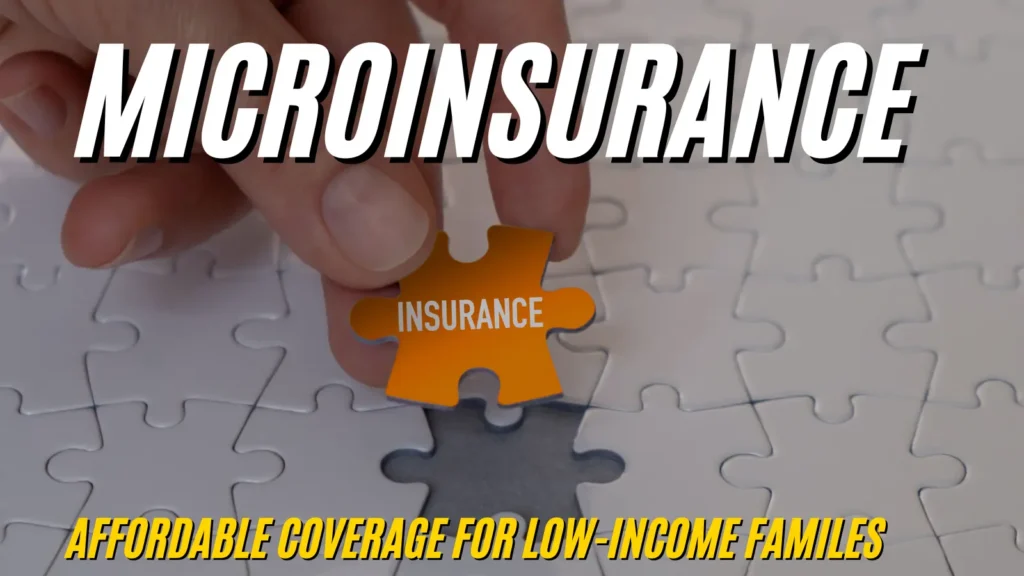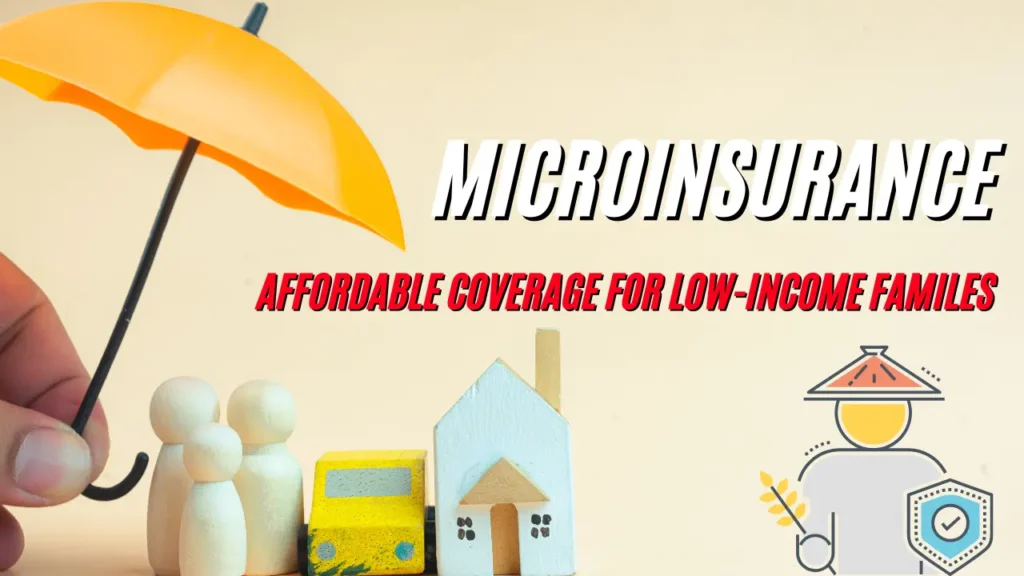What do you think about when it comes to insurance? For most of us, the idea is to have a safety net for what we cannot predict — an illness or injury that comes out of nowhere, say; damage done in your home-ownership life ((something caused by years and years) (Plaster & Waterproofing Sydney )• roof repair gold coast); losing someone you love.
However, for families with low incomes regular insurance is often unaffordable and puts them at risk against life´s eventualities. Enter microinsurance, a lower-cost assurance that prevents such hardship. Microinsurance is now recognized as one of the transformative and effective tools changing lives for low-income families across the globe, in this article find out what it means, and how it works.
What’s Microinsurance?
Microinsurance is a sort of coverage designed especially for low-income individuals and families. It offers coverage for precise risks—including health, existence, or agricultural losses—at notably lower charges than traditional coverage. The intention of microinsurance is to make economic safety available to folks who normally can’t have enough money for traditional coverage plans. With the aid of masking the most essential factors of lifestyles—health, dying, and livelihood—microinsurance facilitates low-earning families to avoid falling deeper into poverty when disaster movies.

Types Of Microinsurance
There are numerous styles of microinsurance tailored to meet the unique desires of low-profits households. Let’s explore the most commonplace kinds:
Health microinsurance
Health microinsurance gives insurance for medical prices. Low-income families often battle to pay for healthcare and this kind of insurance guarantees they can receive medical treatment without going through large sums of money owed. Insurance usually includes hospitalization, outpatient care, and every so often even preventive offerings.
Life microinsurance
Life microinsurance gives monetary safety for a circle of relatives in the event of a loved one’s death. Whilst the payouts are usually smaller than conventional life insurance, they may be nevertheless sizeable enough to cover funeral charges or provide a monetary cushion for the family. This is particularly essential for low-income families that rely on an unmarried breadwinner.
Crop microinsurance
Farmers are most vulnerable to adverse weather and therefore, need crop microinsurance. Crop microinsurance also provides insurance to cover crop failure due to droughts, floods, or pests. This insurance helps to provide a financial cushion for farmers following disastrous harvests and allows them the ability to continue farming in years ahead.
How Microinsurance Works
Microinsurance operates on a simple premise: low rates and focused insurance. Here’s how it works:
Rates and advantages
The rates in microinsurance rules are set at very low degrees, making it less expensive for low-profits people. In alternative to those small payments, the policyholder receives insurance for unique dangers. While the payout quantities are decreased than traditional coverage policies, they’re enough to cover critical desires like hospital treatment, funeral fees, or lost vegetation.
The function of insurers in microinsurance
Insurers presenting microinsurance regularly collaborate with nearby organizations, non-earnings, or network companies to reach their audience. These partnerships are vital because they assist in constructing agreements within the network and ensure that human beings understand how to access and use the coverage.
Microinsurance in extraordinary areas
The impact of microinsurance varies depending on the area, but it’s been particularly a hit in developing nations in which getting admission to conventional coverage is confined.
Microinsurance in growing international locations
In areas like South Asia, sub-Saharan Africa, and Latin America, microinsurance has ended up being an effective device for poverty relief. Governments and NGOs in these regions frequently sell microinsurance applications as part of broader efforts to provide social protection to vulnerable populations.
Urban vs. Rural microinsurance
In city areas, fitness and life microinsurance regulations tend to be more commonplace, addressing the needs of families going through medical emergencies or the loss of a breadwinner. In rural regions, particularly wherein agriculture is a primary livelihood, crop microinsurance is more universal, protecting farmers from the financial devastation of a failed harvest.
Advantages of microinsurance
Microinsurance offers numerous wonderful blessings for low-earnings households:
Affordability and accessibility
The maximum gain of microinsurance is its affordability. With the aid of keeping charges low, microinsurance allows individuals who could otherwise not be able to have enough money coverage to gain admission to economic protection. This makes it a realistic solution for hundreds of thousands of families residing in poverty.

Decreasing economic risk
Without microinsurance, low-income families are frequently compelled to promote belongings, borrow money, or forego critical care whilst catastrophe strikes. Microinsurance reduces these dangers with the aid of imparting well-timed economic assistance, allowing families to recover quickly and keep away from similar hassle.
Demanding situations of microinsurance
Notwithstanding its advantages, microinsurance faces numerous challenges:
Lack of understanding
One of the largest boundaries is that many low-earnings individuals are not conscious that microinsurance exists. Even when they know about it, there’s frequent confusion about how it works, which can prevent people from enrolling in these packages.
Operational challenges
Implementing microinsurance in faraway or underserved areas may be tough. Insurers have to locate methods to reach humans in remote groups, train them approximately in the policies, and ensure that claims are processed efficiently. Those operational demanding situations can every so often restrict the scalability of microinsurance programs.
How microinsurance differs from traditional coverage
There are several key differences between microinsurance and conventional coverage:
Insurance and expenses
Conventional coverage guidelines commonly offer broader insurance and large payouts, however they come with better premiums. In contrast, microinsurance
specializes in specific risks and offers smaller payouts, making it greater inexpensive for low-income families. The trade-off is that at the same time as microinsurance provides critical coverage, it may not be enough for huge-scale screw-ups or scientific emergencies.
Simplicity in claims
Microinsurance policies are designed to be simple, with sincere phrases and clean-to-recognize conditions. The claims procedure is likewise streamlined to make sure that payouts take place quickly. This simplicity is essential for low-earnings households who need on-the-spot monetary relief after a disaster.
Microinsurance vendors and their services
Several global and local insurers are stepping into the microinsurance market, offering a variety of products tailored to the needs of low-income individuals:
Leading Providers
Industry players such as Allianz, AXA, and other players in microinsurance consisting of MicroEnsure and BIMA are at the center of implementing this microinsurance. Most of these providers then collaborate with community-orientated institutions to develop products relevant to the different risks associated with low-income earner families.
Main carriers
Groups like Allianz and Axa, and specialized microinsurance agencies like Microensure and Bima are leading the manner in supplying microinsurance. These providers regularly work with network businesses to create merchandise that addresses the particular dangers confronted by low-profit households in one-of-a-kind regions.

Microinsurance For Health
Health microinsurance is a vital device for low-profit households who could otherwise keep away from searching for hospital treatment because of the high cost of treatment. Using overlaying critical medical offerings, health microinsurance ensures that households don’t have to choose between their health and their economic well-being.
Lifestyles microinsurance: defensive livelihoods
Life microinsurance is especially critical for families living in poverty. The lack of a breadwinner can plunge a family into economic instability. Lifestyles microinsurance gives a financial cushion that helps households cover funeral fees and maintain some balance in the course of a difficult time.
Crop Microinsurance: Supporting Farmers
To farmers, micro-insurance on crops is the greatest hope. Harsh climates and other calamities can destroy harvests for a whole season and families cannot get income from it. Crop microinsurance assists policyholders in dealing with such losses, so they can keep farming and feed their families.
The destiny of microinsurance
The destiny of microinsurance seems promising, with improvements on the horizon to be able to make it even more accessible:
Growth potential and innovations
As mobile technology and virtual bills come to be extra great, microinsurance is becoming simpler to administer. Cell-primarily based insurance guidelines and digital claims processing are making it possible to reach extra people in remote areas and reduce the operational demanding situations of microinsurance.
The case has a look at the microinsurance success tale.
Microinsurance has already made an enormous impact in many communities. Take, for instance, the tale of farmers in Kenya who’ve benefited from crop microinsurance. When an excessive drought struck, many farmers lost their entire harvests. However, folks who had bought microinsurance were able to recover financially and keep farming the following season, averting the long-term results of poverty.
Conclusion
Microinsurance is a powerful tool in the combat opposition to poverty. By presenting low-priced and handy coverage, it affords a safety net for low-earnings households when they need it maximum. As focus grows and technology improves, microinsurance will continue to amplify, giving more people the possibility to defend themselves from life’s sudden demanding situations.
FAQs
What is microinsurance and who is it for?
Microinsurance is a low-cost insurance option designed for low-profit people and families. It covers precise risks like fitness, lifestyles, and crop losses.
What styles of dangers does microinsurance cover?
Microinsurance normally covers fitness expenses, lifestyle insurance for funerals and own family aid, and crop coverage for farmers dealing with harvest losses because of natural screw-ups.
How can microinsurance help low-earnings households?
With the aid of providing affordable rates, microinsurance enables low-earning households to shield themselves from monetary smash after a medical emergency, loss of life of a breadwinner, or crop failure.
What are the demanding situations of microinsurance?
Some of the main challenges include a lack of knowledge about microinsurance and operational problems in achieving far-off groups.
Wherein is microinsurance most common?
Microinsurance is most generally discovered in growing international locations, especially in regions like South Asia, sub-Saharan Africa, and Latin America.


